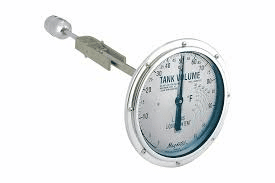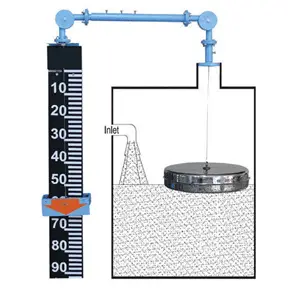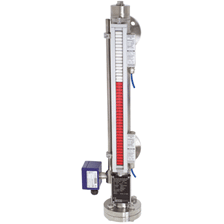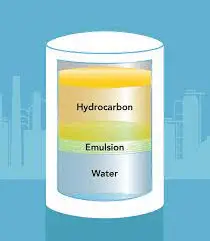Level measurement is most important for process control. Level measurement is the process of measuring the amount in terms of the level of material in a vessel.
The manual level measurement requires a person to view levels periodically and sometimes continuously in case of emergencies. Thus, this method is a very basic method and also a very old one. Some of the methods are using a tape or ruler or dipstick or viewing level in a level gauge.
Why do we need level measurement?
- To know the inventory in terms of volume or weight using a tank gauging system.
- Level measurement is a must for increasing process efficiency. If the tank is not fully filled then it will require more tanks. This will incur an unnecessary cost of more tank installation and maintenance.
- One of the most important factors is safety. If the tank is overfilled, then spillage will occur. And if the material is hazardous, then it can cause damage to life as well as the environment
- To maintain a consistent supply and demand cycle continuously measuring tank or vessel level is most important
- To save equipment like a pump from going into cavitation under low level of the tank.
Types of level measurement used in industries
Today in this modern world, we usually measure levels in 2 forms using modern instruments.
- Continuous level measurement i.e. in % from 0 % to 100 % using level sensors.
- Point level measurement senses the falling level below a defined level and also senses the rising level above a defined level using a level switch. This is the level measurement based on continuous or spot levels.
Level gauges are also used for measurement of level and they show us the readings in the field.
Types of Level Gauges
1. Glass type level gauge
This is the simplest form of level gauge installed in the field. There is a transparent glass tube installed in parallel with a tank. The level shown in the gauge is the same as the level in the tank because of the law of hydrostatic paradox.

2. Ball Float type level gauge
In this type of level gauge, a ball float is there in the tank. The ball moves up and down as the tank’s level varies. This ball is attached to a mechanism that shows the tank level.

3. Chain float type level gauge
The chain float type level gauge is widely used. This level gauge has a floating element in the tank. This floating element has its attachment to a pulley-type mechanism outside the tank. The level variation in the tank moves the pulley up and down which shows the level in scale behind it.

4. Magnetic strip type level gauge
Magnetic strip level gauge is now becoming famous among users. A magnetic float floats in a chamber beside the tank. This float has strips near its vicinity. When float moves from this strip up or down, the color change of the strip occurs. This color change occurs due to the flipping of strips.

Direct Level Measurement
A level transmitter directly measures the level after its mounting on the tank or vessel top. The level transmitter does not come in physical contact with the material filled inside the tank or vessel.
A very big advantage of the direct level measurement method is that this method does not depend upon the density of the filling material. Hence, it is most suitable for varying process conditions such as varying temperature and varying density.
Capacitance, Ultrasonic, and radar level transmitters are very famous indirect level measurement categories. A capacitance level transmitter is a type of contact level transmitter. The capacitance forms between the rod and the wall of the vessel. When the material comes between the rod and the wall, the capacitance changes. This change in capacitance has a certain relationship with the level of the material in the tank.
Radar and ultrasonic work on the principle of time of flight. The time of flight is the time of wave from the sensor to material and back to the sensor.
Radiation and LASER level measurement techniques are useful for measuring levels but under very specific and typical applications where capacitance, ultrasonic, or radar level transmitters do not work.
Tank Gauging System
One more typical application using direct level measurement is the tank gauging system, which takes into consideration the tank level, temperature, and density and thereby tells us the volume or the weight of the material present in the tank. This tank gauging system is the most common system in tank farms(a place in the process industry where many tanks are present and input and output of material from the plant is through these tank farms only).
Another most important feature in level measurement is interface measurement. In the interface we have more than 1 type of fluid in a tank or vessel and using the interface feature of level measurement, we can determine the exact levels of all fluids filled up in the tank or vessel.

Infrared Level Measurement
- In inferred level measurement technique, we often infer level from another parameter of the process called pressure.
- The pressure or better-called head is directly proportional to the height of the filled material and the density of the filled material and also this pressure is directly proportional to the level of the filled material
- This way we can measure the material’s level by measuring the pressure or head generated by the material
- As shown below image, a tank filled with any material will exert pressure.
- We can do two tapings, one from the bottom of the tank and the other from the top of the tank.
- Two tapings are termed HP taping and LP taping (in our case LP is open to the atmosphere as the tank is open) respectively.
- There are many configurations available like a closed tank with dry leg, closed tank with wet leg, tank with elevated zero, and tank with suppressed zero.
- Now it is possible to calculate the level by calculating the height from the formula(different formulas for different configurations)
- Pressure = density * gravitational force * height of the material

There are many variations in this method because the tank or the vessel can be open to the atmosphere or closed tank with some pressure or closed tank in a vacuum, hence the method used to calculate the level using this technique varies.
Read Next: